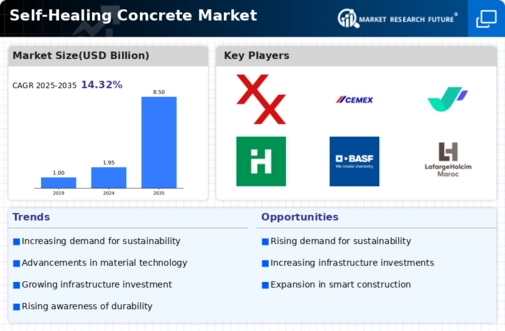Top Industry Leaders in the Self-Healing Concrete Market
 The self-healing concrete market, once a futuristic dream, is rapidly solidifying into a multi-billion dollar reality. This innovative technology promises to revolutionize the construction industry by repairing cracks and damage autonomously, extending lifespan and reducing maintenance costs. But beneath the surface of this seemingly utopian market lies a fierce competitive battleground, where established giants clash with nimble startups, and groundbreaking research fuels a constant race for the next big innovation.
The self-healing concrete market, once a futuristic dream, is rapidly solidifying into a multi-billion dollar reality. This innovative technology promises to revolutionize the construction industry by repairing cracks and damage autonomously, extending lifespan and reducing maintenance costs. But beneath the surface of this seemingly utopian market lies a fierce competitive battleground, where established giants clash with nimble startups, and groundbreaking research fuels a constant race for the next big innovation.
Strategies Adopted by Market Titans:
-
Construction Giants: LafargeHolcim, HeidelbergCement, CEMEX – These industry veterans leverage their global reach, established distribution networks, and brand recognition to dominate the market. They prioritize partnerships with research institutions and focus on developing commercially viable self-healing concrete solutions for large-scale infrastructure projects.
-
Chemical Companies: BASF, Sika AG, Xypex Chemical Corporation – These players leverage their expertise in chemical formulations and materials science to develop self-healing additives and capsules for concrete. They often partner with construction companies or license their technology for wider adoption.
-
Emerging Startups: Basilisk, Biomason, Heijmans – These nimble players bring fresh perspectives and disruptive technologies. They focus on niche applications, like bio-based self-healing mechanisms, or specialize in specific concrete types like precast panels. Their agility and targeted solutions help them carve out spaces within the larger market.
Factors Influencing Market Share:
-
Technology Type: Offering a diverse range of self-healing mechanisms, such as encapsulated bacteria, microcapsules with healing agents, or intrinsic fiber reinforcement, caters to different types of damage and project requirements.
-
Cost-Effectiveness: Balancing the initial cost of self-healing concrete with the long-term savings from reduced maintenance and extended lifespan is crucial for market adoption.
-
Sustainability Focus: Integrating recycled materials, optimizing production processes, and developing self-healing solutions for green infrastructure projects resonates with environmentally conscious governments and developers.
-
Durability and Performance: Ensuring the self-healing concrete maintains its structural integrity and desired properties over time is essential for building trust and confidence in the market.
-
Regulatory Landscape: Addressing concerns about safety, long-term performance, and standardization through regulations and certifications will pave the way for wider acceptance of self-healing concrete.
Key Players:
Basilisk (Netherlands)
Acciona S.A. (Spain)
Akzo Nobel N.V. (Netherlands)
CEMEX S.A.B. de C.V. (Mexico)
Sika AG (Switzerland)
Devan-Micropolis (Portugal)
Fescon (Finland)
Recent Developments:
-
July 2023: Basilisk secures funding for a large-scale demonstration project of self-healing concrete roads, paving the way for real-world implementation.
-
September 2023: Heijmans introduces a self-healing concrete solution specifically designed for precast panels, opening up new application possibilities.
-
October 2023: Biomason announces progress in developing a self-healing concrete using bio-engineered bacteria, pushing the boundaries of bio-based solutions.
-
November 2023: Xypex Chemical Corporation collaborates with universities to develop new self-healing mechanisms for concrete exposed to extreme weather conditions.
-
December 2023: CEMEX invests in a research facility dedicated to self-healing concrete, showcasing its commitment to innovation in this sector.










